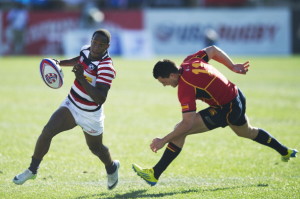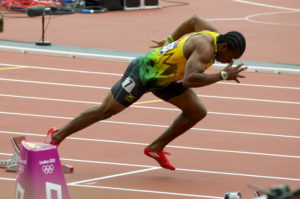Hi readers, Chris and I have a new page on sprinting launched! We’re excited to release this new page, as we think it’s a very valuable resource for the Strength & Conditioning and Track & Field communities. Here is a brief introduction to the topic.
Over the past several years, I’ve become fascinated with sprint biomechanics and the literature pertaining to sprinting (actually, there are a lot of types of “sprinting,” which is why researchers typically refer to sprinting pertaining to gait as “sprint running”).
A while back, I managed to drag Chris into my obsession, and he’s now every bit as fascinated with the topic as I am (which is why Chris and I get along so well). So now I have a partner in crime, and Chris and I are now publishing our own research in the form of columns and review articles. We are also conducting our own original research, thereby adding to the body of knowledge. This is a huge honor – to “give back” and contribute to the field we love.
Before we started our research, it was vital that we possessed a good command of the prior sprint research literature. We needed a proper handle on various biomechanical topics inherent to the sprinting world. We want to share this knowledge with you so that can benefit from our intensive research and countless discussions.
Before you delve into this page, I’d like to discuss certain things up front. First things first – it is essential that you familiarize yourself with the body of literature pertaining to a particular topic prior to formulating your opinion. One drawback I see with many aspiring sprint biomechanists or sport scientists is that they read a single study and take it at face value without adequately understanding the studies that came before or followed that paper. Second, it is imperative that you are patient with the literature. Throughout the page you will notice many contradictions in the research. However, you’ll also notice many common threads, and these threads are what you should cling to. Science is always evolving, and our understanding of things continues to progress. In ten years we’ll have answered many questions in sprinting, but there will undoubtedly be many new ones that crop up. Things we currently take for granted as being right might be incomplete, things we wrote off as wrong might in fact be correct or at least partially correct, and things we can’t imagine at the moment will suddenly emerge, therefore we must be open to avenues and angles previously unconsidered. Third, you must understand the strengths and weaknesses of each study. No study in and of itself is the end-all-be-all, but rather each study forms a small piece of the “sprinting puzzle.”
I would like for you to be a student of sprinting, just as I am. I would like for you to appreciate the past classic research of sprint biomechanists such as Mann and Weyand, the important contributions from Hunter, the more recent popular contributions from folks like Morin and Schache, the time-consuming review articles that have been compiled for our benefit, and the evolution of sprint knowledge in general. I urge you to not idolize any researcher or sprint expert – I can assure you that none of them have all the answers. They’re all human and have been wrong many times over (it happens to all good scientists). Instead, I’d like for you to become your own expert and formulate your own thoughts and ideas. I want you to get out of your comfort zone and delve heavily into the science of sprinting, just as I did several years back.
How do things change when constant running speed increases from submaximal to maximal in addition to when accelerating from a standstill to maximal speed? Which joints go through more or less range of motion? How does posture change? Which muscles are more highly activated? Which joints increase in torque and angular velocity the most? What happens to ground reaction forces? What about stride length and stride rate, in addition to contact and flight time? What factors best predict faster sprinting? Which types of genetic and architectural factors are at play? Are relative vertical force, impulse, and power characteristics more important than relative horizontal force, impulse, and power characteristics, or vice-versa? How important is stiffness? Which mechanical qualities deteriorate under fatigue, and how does the body try to compensate? Are neuromuscular or metabolic factors more crucial for sprinting prowess? Which muscles are the key “sprint muscles”? How should a sprinter warm-up? How does one best train for acceleration versus maximal speed? What factors influence transfer of training to performance? What ultimately limits humans from springing faster? What characteristics make Bolt, Gay, and LeMaitre unique? What research are you hoping to see conducted as time ensues? And what in the hell is Morin’s “Direction of Force Application Technique” anyway? These are all important questions to ask yourself.
Whether you’re a starving college student majoring in sports science, an aspiring sprinter, an avid lifter or athlete, a coach or trainer, a researcher, or simply a closet biomechanics aficionado, I’m sure that you will appreciate the content contained within this page. I recommend that you print it and take notes or highlight certain portions as you’ll likely be referring to it again down the road. We chose to organize the page into various categories, with the training studies at the top and the biomechanics lower down.
Pay attention to the dates of the different studies as we made sure to include research from the 1920’s all the way up to the present day. I hope you enjoy this material as much as I do! – Bret Contreras
Now go and check out our new sprinting page!








Does the book have images and easier-to-understand sections to help those of us not as anatomically knowledgeable?
Hi Rick, no images, but we have tables at the front of the book that summarize each study. You don’t need to know much anatomy for this product, but the biomechanics can get pretty thick in some parts. Cheers!
Thanks, Bret. I will have to pass for now because I need something more accessible. Thank you for your honest reply.
Bret, you put out so much great information which we all appreciate, but would you not one day want to get your hands on some athletes (sprinters for example) and try and put all of your knowledge into practice? Tom
Hell yeah I would! I first wanted to get my PhD and do tons of research just so I’m aware of what’s out there and the questions that need to be answered. I’m still young – I anticipate that I’ll one day work with athletes and maybe even elite athletes to add to the research on elite sprinters.
2013 NFL combine: Big butts matter for offensive linemen
http://www.sbnation.com/nfl/2013/2/23/4020966/2013-nfl-combine-offensive-lineman-butt-size
Tom, I think that would be a great idea. I would be curious to see how this would play out with actual top end athletes that are sprinters.
Nice job! LIKE, LIKE!!
Bret, Sorry for the off-topic but is there going to be another edition of The Sexy Challenge this year?
Ted
I am going to take a look at this product. I have been wanting to add a conditioning aspect to my game around sprinting and I am hopeful this will help.
I was never very interested in sprinting and running in general, but I`ve changed drastically over the course of the last few months. I`ve discovered it`s full benefits and I am interested in finding out more.
Looks like this book might be just the thing I need Bret, thanks for letting us know. I will look more into it and hopefully buy it.
Regards
Hi Bret,
Great resource, thanks. Now, before diving into this book, I wanted to know what your thoughts are on sprinting as a weight loss tool. I usually do my morning 2K five times a day, and I’ve realized that while I’ve lost a lot of weight, I’m getting quite a bit of muscle mass. Do you think sprinting is good for toning your body compared to long runs?
Alana